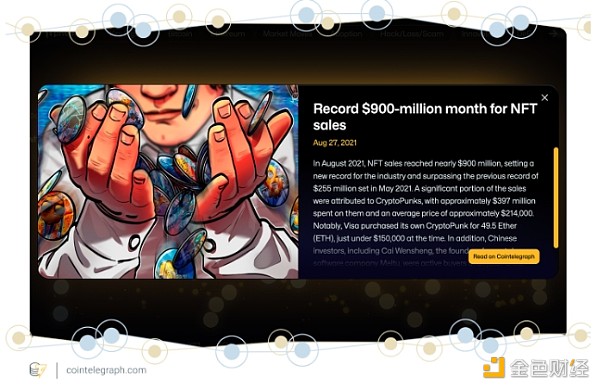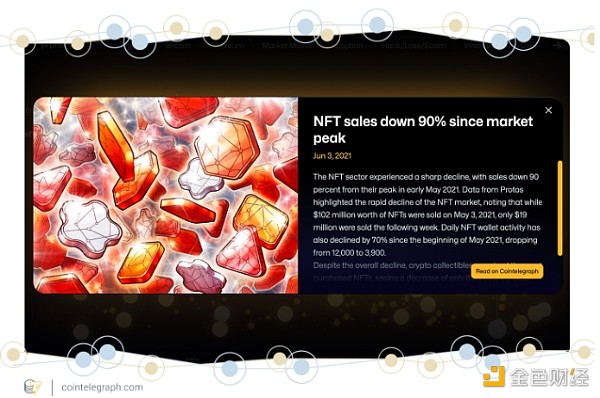Author: Zhiyuan Sun, CoinTelegraph; Compiler: Deng Tong, Golden Finance
Amid the hustle and bustle of the digital age, where trends are constantly changing, one phenomenon has stood out like no other: non-fungible tokens (NFTs). 2020 and 2021 have been a period of unprecedented growth and widespread adoption for these digital assets, reshaping how we think about ownership, art, and the internet itself. In fact, NFT market volume reached approximately $25 billion in 2021 alone, an indicator that was almost non-existent a few years ago.
Related content:
Tracing the History of Cryptocurrency (I): Satoshi Nakamoto's Response to the Financial Crisis
Tracing the History of Cryptocurrency (II): Ethereum's Joining and Bitcoin's Surge
Tracing the History of Cryptocurrency (III): ICO Boom and the Evolution of Ethereum
Tracing the History of Cryptocurrency (IV): The Great Crash and Ethereum's Mainstream Recognition
Tracing the History of Cryptocurrency (V): The DeFi Revolution During the Global Crisis
While the concept of blockchain technology has been around for more than a decade, the emergence of NFTs has captured the imagination of creators and collectors. NFTs represent unique digital assets stored on a blockchain, ensuring their scarcity and authenticity. This innovation allows the tokenization of digital art, music, videos, and even tweets, turning intangible creations into valuable commodities.
The concept of NFTs dates back to at least 2012, when the Colored Coins protocol was created on the Bitcoin blockchain. The protocol allows users to issue custom tokens representing digital or physical assets. However, it was not until later, with the advent of Ethereum smart contracts and the ERC-271 token standard in 2017, that non-fungible tokens specifically for digital assets became possible.

CryptoKitties is one of the earliest and most famous examples of NFTs that gained widespread attention in 2017. Developed by Canadian studio Axiom Zen, CryptoKitties is a blockchain-based virtual game that allows players to buy, collect, breed, and sell virtual cats. With the success of CryptoKitties, many other projects began to experiment with using NFTs for various purposes, including digital art, virtual real estate, in-game items, and more. Platforms such as Decentraland and NBA Top Shot gained attention during this period, demonstrating the diverse applications of NFTs beyond gaming.
Then, mainstream adoption exploded between 2020 and 2021.
In 2021, NFTs reached new levels of mainstream acceptance as high-profile sales made headlines, including multimillion-dollar digital artworks and celebrities launching their own NFT collections. On November 2, 2021, award-winning writer and director Quentin Tarantino announced that he would auction off seven uncut scenes from Pulp Fiction as NFTs on a secret network.
Other auctions also made fascinating headlines, such as the March 2021 sale of Beeple’s digital artwork Everyday: The First 5,000 Days for $69 million at Christie’s. New digital artworks by artists like Pak and Grimes fetched millions of dollars at auction. During this period, iconic series like Bored Ape Yacht Club and CryptoPunks were also born.

Each is part of a collection of 10,000 algorithmically generated profile pictures. In March 2021, a CryptoPunk NFT (#7804) sold at auction for over $7.5 million, setting one of the highest prices for a single CryptoPunk at the time. Following this milestone, in October 2021, a rare Triple Bored Ape set (consisting of three apes) sold as a bundle at a Sotheby’s auction for over $24 million. Meanwhile, the number of NFT marketplaces has expanded rapidly during this period. Platforms such as OpenSea, Rarible, Foundation, and Nifty Gateway have gained popularity, providing avenues for creators to mint and sell digital assets. OpenSea has become one of the largest NFT marketplaces, with monthly trading volumes exceeding $1 billion by mid-2021, a figure subsequently surpassed by Blur and OKX NFT.
However, this surge in popularity has also brought criticism of environmental issues and questions about the intrinsic value of digital assets due to the energy-intensive nature of blockchain transactions. In fact, during the crypto winter of 2022-2023, NFT trading volume fell a staggering 99% from its 2021 peak.

Legal disputes over the ownership and authenticity of digital assets have also emerged, highlighting the need for clear regulations and guidelines. Some platforms have implemented verification mechanisms to verify the originality of NFTs and protect the rights of creators, while others have worked to define ownership in a decentralized ecosystem. In fact, as the Pulp Fiction NFT became widely publicized, Miramax sued the Hollywood director in a copyright lawsuit, which was settled in September 2022. BAYC and Yuga Labs, the current owner of the CryptoPunks series, have faced similar digital legal battles.
All is not lost, however. As the crypto bull run continues, NFT trading volumes have recovered. New NFT projects, especially in Hong Kong, have surged in popularity, with collectibles being snapped up shortly after release. New protocols such as ParaSpace (now Parallel Finance) are developing new tools for the growing NFT lending market. Meanwhile, new Ethereum token standards such as ERC-404 seek to segment NFTs and make them widely available.
Overall, the NFT space continues to evolve, with various industries continuing to experiment and new platforms emerging to meet the needs of different sectors in the NFT ecosystem. Additionally, efforts are underway to address environmental issues and improve the sustainability of blockchain technology as developers and enthusiasts seek to ensure the long-term viability of NFTs as a form of digital ownership and expression.
 Alex
Alex
 Alex
Alex Weiliang
Weiliang JinseFinance
JinseFinance Weiliang
Weiliang Sanya
Sanya Catherine
Catherine Cointelegraph
Cointelegraph Cointelegraph
Cointelegraph Cointelegraph
Cointelegraph Cointelegraph
Cointelegraph